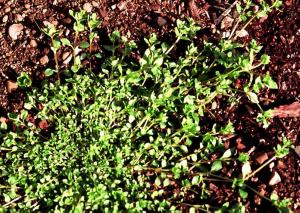CONTENTS
Registered Herbicides
[Return to weed
Identification]
[Return to Weed
Management]
[Home] |
|

General Description:
- slender, tender prostrate stems with numerous
branches.
- branches have fine hairs arranged in rows.
- leaves are opposite and about 1/2 inch long.
- leaves at terminal end of branch do not have petioles.
- small white flowers with 5 deeply notched petals that
are shorter than sepals.
- shallow fibrous root system.
Life cycle: annual
- reproduces by seed and rooting at nodes on prostrate
stems.
- fruit contains many seeds within a dry capsule.
- seeds germinate in early spring and late summer.
- may produce one or two generations within one year.
- flowers early spring to fall.
Habitat/ Crops associated with:
- prefers shady, cool, and moist environments.
- found in turfgrass, nursery crops, cultivated
horticultural and agronomic crops.
Herbicide Control Notes:
- Karmex/Direx or Sinbar are effective. Add Gramoxone if
chickweed is well established.
|